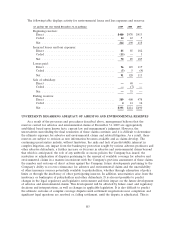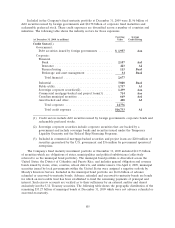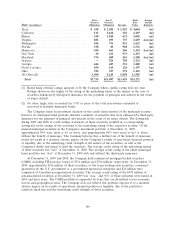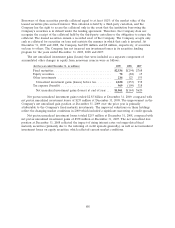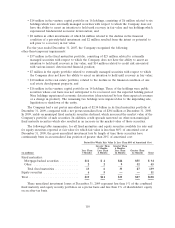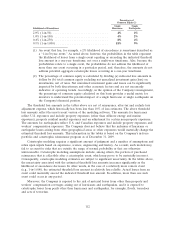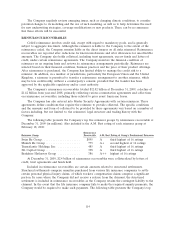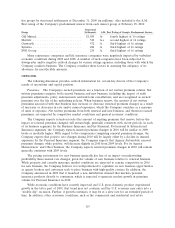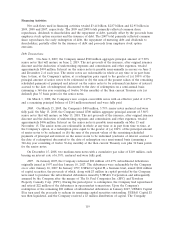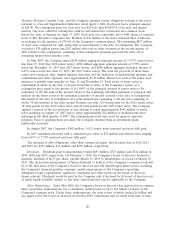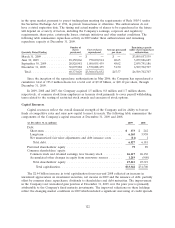Travelers 2009 Annual Report Download - page 125
Download and view the complete annual report
Please find page 125 of the 2009 Travelers annual report below. You can navigate through the pages in the report by either clicking on the pages listed below, or by using the keyword search tool below to find specific information within the annual report.There are no industry-standard methodologies or assumptions for projecting catastrophe exposure.
Accordingly, catastrophe estimates provided by different insurers may not be comparable.
For more information about the Company’s exposure to catastrophe losses, see ‘‘Item 1A—Risk
Factors—Catastrophe losses could materially and adversely affect our results of operations, our
financial position and/or liquidity, and could adversely impact our ratings, our ability to raise capital
and the availability and cost of reinsurance.’’
CHANGING CLIMATE CONDITIONS
Severe weather events over the last several years have underscored the unpredictability of future
climate trends and created uncertainty regarding insurers’ exposures to financial loss as a result of
catastrophe and other weather-related events. Some scientists believe that, in recent years, changing
climate conditions have added to the unpredictability, frequency and severity of natural disasters.
Accordingly, if climate conditions change in the future, the Company’s catastrophe models may be less
reliable.
The Company discusses how potentially changing climate conditions may present other issues for
its business under ‘‘Risk Factors’’ in Item 1A of this report and under ‘‘—Outlook’’ herein. For
example, among other things:
• Increasingly unpredictable and severe weather conditions could result in increased frequency and
severity of claims under policies issued by the Company. See ‘‘Risk Factors—Catastrophe losses
could materially and adversely affect our results of operations, our financial position and/or
liquidity, and could adversely impact our ratings, our ability to raise capital and the availability
and cost of reinsurance’’ and ‘‘—Outlook—Underwriting Profitability.’’
• Such changing climate conditions could also impact the creditworthiness of issuers of municipal
and corporate securities in which the Company invests. For example, water supply adequacy
could impact the creditworthiness of municipal bond issuers in the Southwestern U.S. and more
frequent and/or severe hurricanes could impact the creditworthiness of issuers in the
Southeastern U.S., among other areas. See ‘‘Risk Factors—Our investment portfolio may suffer
reduced returns or material losses.’’
• Increased regulation adopted in response to potential changes in climate conditions may impact
the Company and its customers. For example, state insurance regulation could impact the
Company’s ability to manage property exposures in areas vulnerable to significant climate driven
losses. If the Company is unable to implement risk based pricing, modify policy terms or reduce
exposures to the extent necessary to address rising losses related to catastrophes and smaller
scale weather events (should those increased losses occur), its business may be adversely
affected. See ‘‘Risk Factors—Catastrophe losses could materially and adversely affect our results
of operations, our financial position and/or liquidity, and could adversely impact our ratings, our
ability to raise capital and the availability and cost of reinsurance.’’
• The full range of potential liability exposures related to climate change continues to evolve.
Through the Company’s Emerging Issues Committee and its Committee on Climate, Energy and
the Environment, the Company works with its business units and corporate groups as
appropriate to identify and try to assess climate change-related liability issues, which are
continually evolving and often hard to fully evaluate. See ‘‘Risk Factors—The effects of
emerging claim and coverage issues on our business are uncertain.’’
Climate change regulation also could increase the Company’s customers’ costs of doing business.
For example, insureds faced with carbon management regulatory requirements may have less available
capital for investment in loss prevention and safety features which may, over time, increase loss
exposures. Also, increased regulation may result in reduced economic activity, which would decrease
the amount of insurable assets and businesses.
113


